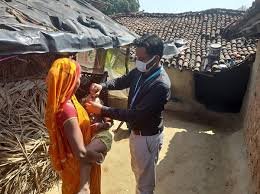New Delhi-India has witnessed a remarkable improvement in child health and immunization coverage, earning recognition on the global stage. According to the 2024 report by the United Nations Inter-agency Group for Child Mortality Estimation (UN IGME), the percentage of zero-dose children — those who have not received a single vaccine — has dropped significantly from 0.11% in 2023 to 0.06% in 2024. This achievement positions India as a model for nations aiming to improve public health outcomes through immunization.
The Universal Immunization Programme (UIP), India’s flagship public health initiative, now covers 12 vaccine-preventable diseases and continues to expand. In 2014, India had only six vaccines under the UIP. Since then, six new vaccines have been introduced, including the Inactivated Polio-virus Vaccine, Rotavirus Vaccine, Pneumococcal Conjugate Vaccine, Measles-Rubella Vaccine, Adult Japanese Encephalitis Vaccine, and the Tetanus-Diphtheria Vaccine. These additions reflect the country’s commitment to enhancing vaccine access and disease prevention.
India’s immunization efforts are grounded in the belief that vaccination is one of the most powerful and cost-effective public health interventions. Each year, India vaccinates approximately 2.6 crore infants and 2.9 crore pregnant women through more than 1.3 crore immunization sessions conducted by dedicated frontline workers such as ASHAs and ANMs. These efforts are supported by large-scale campaigns and programs like Mission Indradhanush, which has vaccinated 5.46 crore children and 1.32 crore pregnant women since its launch in 2014.
The Zero Dose Implementation Plan 2024 has been rolled out across 143 districts in 11 states with a high burden of unvaccinated children. These targeted interventions, especially in underserved areas such as urban slums, migratory communities, and vaccine-hesitant regions, have strengthened last-mile delivery of essential vaccines.
India’s achievements extend beyond vaccination coverage. The country has made significant progress in reducing child and maternal mortality. As per the UN-Maternal Mortality Estimation Inter-Agency Group report (2000–2023), India’s Maternal Mortality Ratio (MMR) stands at 80 per one lakh live births — an 86% decline since 1990, compared to the global reduction of 48%. Similarly, India’s Under-Five Mortality Rate (U5MR) declined by 78%, surpassing the global average of 61%, while the Neonatal Mortality Rate (NMR) fell by 70% against the global average of 54% between 1990 and 2023.
These outcomes are a direct result of India’s consistent prioritization of child health. The launch of platforms like U-WIN has allowed for real-time digital tracking of immunization status, ensuring that no child is left behind. Awareness campaigns through mass media, street plays, and social media have also played a crucial role in reducing vaccine hesitancy and encouraging participation.
India’s antigen-wise immunization coverage now surpasses global averages. According to WUENIC 2023, India’s DTP-1 vaccine coverage is 93% — significantly higher than Nigeria’s 70% — and the dropout rate between DTP-1 and DTP-3 has dropped from 7% in 2013 to just 2% in 2023. Measles coverage also increased from 83% to 93% in the same period.
India’s progress stands out particularly when compared to countries with a high burden of zero-dose children. Countries like Yemen (1.68%), Sudan (1.45%), Angola and Afghanistan (1.1% each), and Nigeria (0.98%) show much higher percentages of zero-dose children compared to India’s 0.06%. Given India’s large population, these figures underline the robustness and scale of its immunization infrastructure.
Global institutions have acknowledged India’s achievements. On March 6, 2024, India was honored with the **Measles and Rubella Champion Award** by the Measles and Rubella Partnership, comprising major global health organizations such as WHO, UNICEF, GAVI, and the American Red Cross. The award ceremony was held at the American Red Cross Headquarters in Washington DC, recognizing India’s dedication to disease elimination.
The benefits of expanded immunization are already visible in reduced morbidity and mortality from diseases like pneumonia, meningitis, encephalitis, and diarrhea. Alongside immunization, India’s public health framework includes National Immunization Days, Pulse Polio Campaigns, and Village Health and Nutrition Days to ensure continuous outreach.
Comparative data from other high-income nations shows India’s standing is competitive — matching or exceeding vaccine coverage levels in countries like New Zealand, Germany, Sweden, and the UK. Given India’s socio-geographic diversity and scale, this is an exceptional achievement.
The Government of India remains committed to strengthening the Universal Immunization Programme. The elimination of Polio in 2014, Maternal and Neonatal Tetanus in 2015, and the recent launch of the Measles-Rubella campaign in 2025 reflect an unwavering commitment to protecting children against life-threatening diseases.
With a proactive strategy, robust public health infrastructure, and dedicated field workers, India’s focus continues to be on last-mile vaccine delivery — ensuring that every child, no matter how remote their location, is given the opportunity to live a healthy life.
Source-PIB






